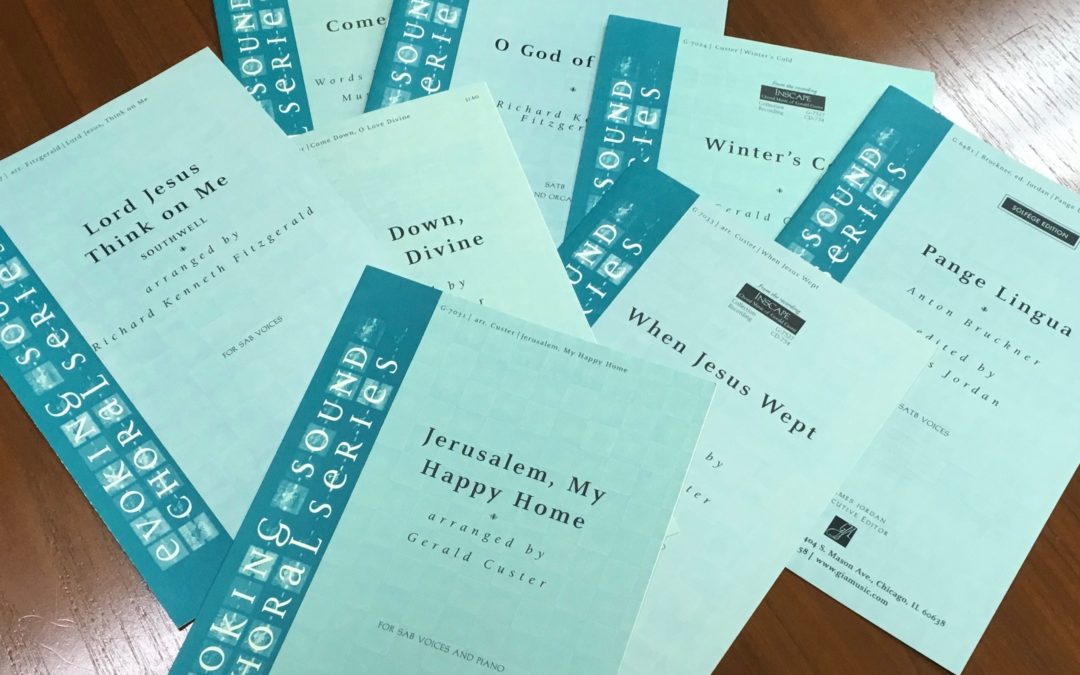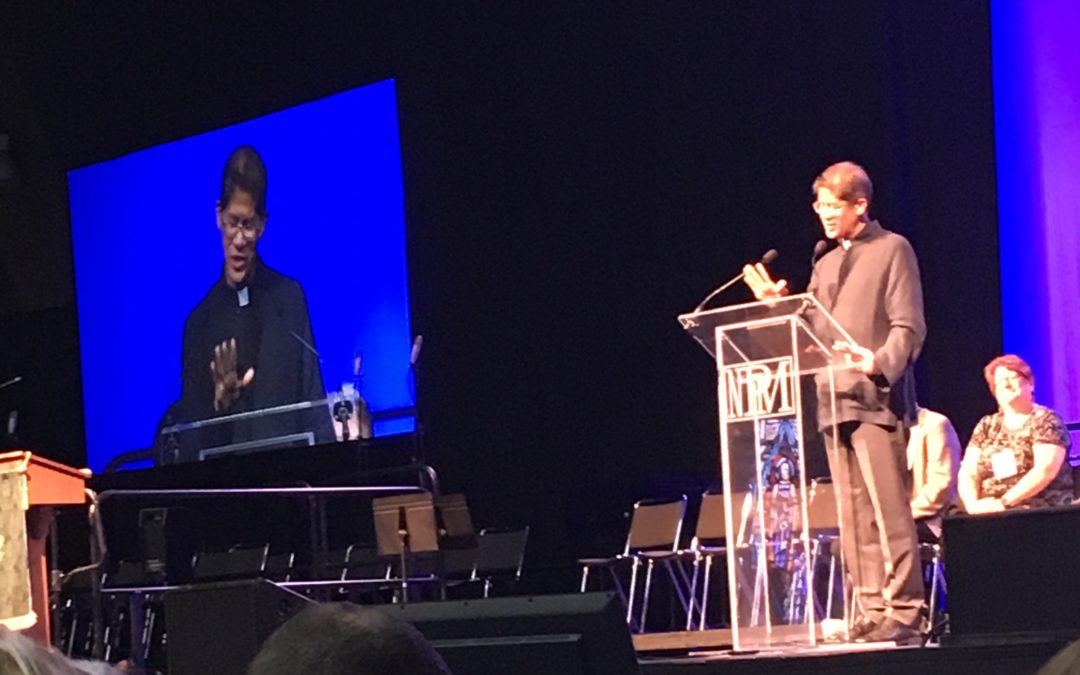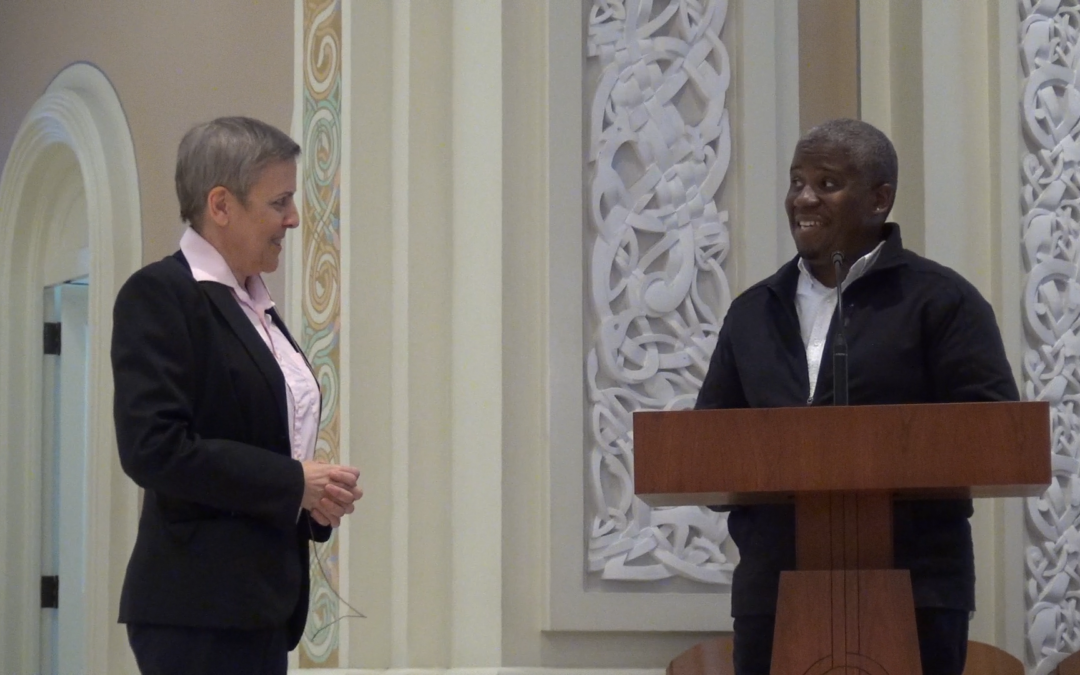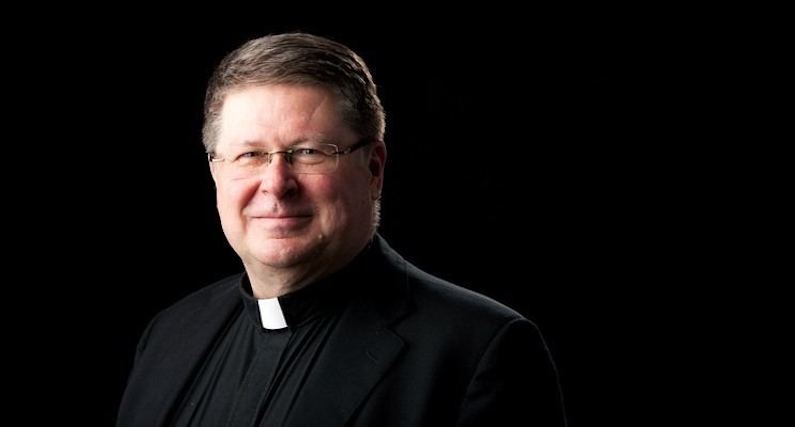Ministering through Music
Keyboard to Keyboard
¡Cantemos Amén!

Sing Amen!: The Podcast, Episode 3: A Sacred Choral Sampler from Evoking Sound Choral Series
Podcast: Play in new window
Greetings, everyone!
With the NPM conference behind us and the various publisher reading sessions still to come, I’m guessing a lot of listeners are in the process right now of choosing new music for their choirs over the coming year. And I’m here today to just compound further the eternal dilemma of “there’s so much great music, how can we possibly sing it all!?” (You’re welcome.)
My job here at GIA is to be the “Editor for Music Formation Resources.” Part of that is generating new materials—print materials like books and articles as well as this SingAmen! online media project. But another part is exploring the “Music Education” side of what GIA is already doing, something a lot of our church music friends may not be very familiar with, and see if there are materials there that can serve us in our churches. (Anyone who came to the GIA Fall Institute last year, and got to learn from Dr. James Jordan from Westminster Choir College, got a taste of that—he is amazing, and I’m thrilled that people on the pastoral music side of things got to hear some of what he has to say. And by the way, he will be back for the institute THIS fall, so if you missed him last October you have another chance—and our next podcast will feature an interview with him, so you’ll get to hear a little more then too.)
One of Dr. Jordan’s projects with GIA has been the “Evoking Sound” choral series, part of a whole series of educational materials he has created and curated over the course of many years. There are a huge number of gorgeous choral works in this series—if you sat down with a pile of them and just went through it, you’d discover that many of them are set to secular texts and very many of them composed at a pretty challenging level—a lot of double choir and divisi kind of writing, the sort of thing that many parish choirs would find a little too challenging. However, a bunch of us went through the entire stack of music and pulled out a subset of pieces that are within the reach of various levels of parish choirs, and I’m going to share a few of those with you today. A lot of this music was recorded by Dr. Jordan with either the Anam Cara chamber choir or his own Westminster Williamson Voices, and it’s just lovely—please see the SingAmen website or GIA publications for more information about the specific works. (And by the way—even though most of this is solid organ-based choral music, I promise I’ll hit some great contemporary resources in a future sampler!)
(Also by the way–if you’ve read this far, you can pretty much skip to about 2:50 in the podcast, because I pretty much say there what I just said here. :-))
So please have a listen! Once the introduction is done, I tried on the podcast to talk as little as possible—only enough to tell you what you’re hearing—and just to let you have half an hour or so of gorgeous choral music. Enjoy!
Music Credits:
Lead me on G-7457
by Brian A. Schmidt
Series: Evoking Sound
Vocal Forces: SATB
Recorded on: Silence into Light, by James Jordan and the Westminster Williamson Voices, CD-1026
Come down O love divine G-7032
by Ralph Vaughan Williams
Text Author: Bianco da Siena
Arranged by: Gerald Custer
Series: Evoking Sound
Vocal Forces: SATB
Accompaniment: Keyboard
Recorded on: Inscape: Choral Music of Gerald Custer, by James Jordan and the voices of Anam Cara, CD-754
Jerusalem My Happy Home G-7031
Arranged by: Gerald Custer
Series: Evoking Sound
Music Source: Early American melody
Vocal Forces: SAB
Accompaniment: Piano
Recorded on: Inscape: Choral Music of Gerald Custer, by James Jordan and the voices of Anam Cara, CD-754
When Jesus Wept G-7033
by William Billings
Text Author: William Billings
Arranged by: Gerald Custer
Series: Evoking Sound
Vocal Forces: SAB
Accompaniment: Piano
Recorded on: Inscape: Choral Music of Gerald Custer, by James Jordan and the voices of Anam Cara, CD-754
Lord Jesus Think on Me G-6237
by Richard Kenneth Fitzgerald
Series: Evoking Sound
Vocal Forces: SAB
O God of Light G-5931
by Richard Kenneth Fitzgerald
Text Author: Sarah Taylor
Series: Evoking Sound
Vocal Forces: SATB
Accompaniment: Organ
Winter’s Cold G-7024
by Gerald Custer
Series: Evoking Sound
Vocal Forces: SATB, Soprano Solo
Separate Instruments: 3 octaves Handchimes
Accompaniment: Piano
Recorded on: Inscape: Choral Music of Gerald Custer, by James Jordan and the voices of Anam Cara, CD-754
Come, O Christ G-6235
by Roger Ames
Text Author: Rembert Herbert
Series: Evoking Sound
Vocal Forces: SATB
Accompaniment: Organ
Pange Lingua Bruckner G-6481
by Anton Bruckner
Text Author: Thomas Aquinas
Edited By: James Jordan
Series: Evoking Sound
Vocal Forces: SATB
Accompaniment: Reduction
The Lord Bless You G-8192
by Peter C. Lutkin
Edited By: Joe Miller
Series: Westminster Choir
Vocal Forces: SATB
Accompaniment: Reduction
SingAmen! the Podcast, with Jennifer Kerr Budziak
Sound by Jim Bogdanich
SingAmen! opening music: Promenade, by Bob Moore (from Let Every Instrument Be Tuned for Praise, CD-491, from Liturgical Suite #4, G-4789.. ©GIA Publications, Inc).
SingAmen! closing music: Amen, (from More Sublime Chant, CD-459, The Cathedral Singers, Richard Proulx, conductor. ©GIA Publications, Inc.)

NPM, day 3: of commitment, kenosis, and time
I came to NPM thinking, “NPM is so full of wonderful things–I will probably write a post every day!”
Instead I find myself both ridiculously busy and so overwhelmed by the various things going through my head that I neither know what to say nor how to say it. Because there is just too much. Listening to Joyce Ann Zimmerman, whom until Monday I only knew through her books and articles from my own theology studies…being brought to tears repeatedly Monday night as Roger Holland and his choir and wonderful speakers led us in song and prayer…feeling the burst of life and joy on what could have been a sleepy Tuesday morning as VaLimar Jansen fired us all up and got is singing and praising…singing the music of St. Hildegard at the prayer service Tuesday night…most of all, Wednesday morning, seeing Ricky Manolo, whom I have known I think since he was a seminarian, receiving his award, and remembering when we were both so young, and he was the exact same gentle kind unassuming light-emitting presence then that he is today…
And seeing so many old friends, and new ones–especially the ones I never see except at NPM conventions. (Some of those same friends actually live here in Chicago near me–and yet still we only seem to see each other when we all travel to different cities for conventions.) Friends from our old Pastoral Ministers yahoo group, most of whom have migrated over to one of the NPM Facebook groups; whenever I hear someone say “real relationships cannot happen online, they must take place face to face!”–I think of these friendships, many of the decades old, and know that it just isn’t true. Friends from college, people I knew back before any of us were thinking of pastoral music as a career, who now find ourselves scattered around the sacred music world, but coming back together here and catching up. And perhaps most of all, new and younger friends–men and women I remember meeting when they were teenagers or interns in conventions past, who are now giving presentations and leading sessions and running whole departments here, with their own parish music programs, their own passions and aspirations and dreams for the world they want to build. it’s sort of odd, and of course it’s been happening for a long time, but I’m beginning to realize that I’m shifting over into being of the “old guard” of the NPM world. I’m of the generation whose part in shaping the organization is still vibrant and working, but whose work continuing work must be to pave the way the new surge of youth and energy that Steve talked about today. (I’m not done, nor am I ancient and decrepit by any means–and yeah, I’m on the younger end of that old guard, so my dear friends and colleagues who are older than me, please don’t think I’m placing you at some point on a continuum–I’m also at that stage in life where it begins to feel like everyone older than me is aging backwards, with way more energy than I have, and I want to know how they do it!)
So I’ve been thinking a lot. I’ve been thinking about passion, and about commitment. I’ve been thinking about power, and kenotic self-emptying, and how dependent they are on each other. And I’ve been thinking about time. How it passes, but at the same time how in moments like this week it seems as though it begins to double on itself, or give us “thin places” as the Celtic tradition refers to them, places where the boundaries seem more fluid than they used to. For me this year, the past and the present feel like they are coming together and almost overlapping. One of those overlaps for me is the memory flashback I keep having to a few NPM’s ago, when Fr. Richard Fragomeni gave a plenum address in a flawless rondo form. (I love it when musician-scholars become homilists; their homilies have such lovely structure.) The recurring “A” theme of his talk has stayed with me; he said: “We die…before we die…so that when we at last come to die…there is not much left of us to die…but only Jesus who lives in us.”
Kenosis. Self-emptying. And once one is empty of one’s own Stuff, there is room there for God to come in. And when we are full of ourselves, how can there be room for God?
Ironically, when I started typing that previous sentence, I was thinking simply in terms of being “full” of the self-stuff before self-emptying, but the phrase “full of ourselves” has its own loaded meaning, doesn’t it? And this kind of “fullness” comes not just with the more obvious trap of ego (“wow, he’s so full of himself!”), but also with the twin trap of fear. Isn’t it, in the moments when we are afraid to step out and give what we have for fear it’s not good enough, or back off from singing the note because we are afraid it won’t come out, or over-plan and over-function in our jobs because we are afraid if we don’t do it it won’t get done and everything will fall apart and the world will end, just as much an ego trip as the conviction that we have it all together and are in some way superior to everyone else?
Which is where commitment comes in. And power. Because once we have committed to emptying ourselves of self, the power of God can come in.
When I watched Roger Holland conducting on Monday night, even amidst being profoundly moved by the music and the prayer, I was struck by the fact that, while the gestures he was using as a conductor were not the ones I’d been taught in conducting study, every single one was exactly what it needed to be to get the response the music was calling for. Not that he was calling for, that the music was calling for. He was fully committed, to the music and the humans making it and the God we all serve, pulling in all his years of study and experience and knowledge but leaving the self-stuff out so that the power of God and the power of the music could work through him. And wow, how they worked.
I felt the same way this afternoon at the Poe event at Westminster (if you didn’t catch that, you have to try and go tomorrow!), as we alternately heard performances of Poe’s poetry and then joined together in gorgeous and thematically connected hymns. The actor portraying Poe was excellent, and of course the poetry of this American master is peerless…but I was most struck by the presence and playing of Lynn Trapp at the organ. I’ve known Lynn for years, but I don’t get to see or hear him play often enough; he’s a stellar organist by any measure, and the prelude music was gorgeous, but even more I noticed and loved the way he led the roomful of singing church musicians. He played a hymn introduction; we started singing. We started slowing down. (Like immediately. Doing exactly what frustrates us when our choirs and assemblies do it. I’m not sure why we do that; is it our lack of commitment that makes us us hang back?) He didn’t push, he didn’t do anything dramatic, he simply…led us back to tempo; a gentle guiding conducting arm from Michael our narrator helped as well. It took maybe 2 bars; from there on, we were in–we were committed, we sang, together, making music, with Lynn at the helm playing some fantastically Poe-like harmonizations of some of the hymns at exactly the right places…with us, not for us. And in the verse where PLEADING SAVIOR went into an a cappella four part canon verse with sopranos starting, after setting up the rhythmic transition from one verse to the next, Lynn just ceased the organ sound and let the sopranos enter on their own. No gesture, no accompaniment, just trust. And after a split second hesitation, they did enter, followed by the rest of the church-filling choir. It was glorious.
Power. Kenosis. Trust.
(I wonder if our actor-Poe had ever performed for an “audience” like this one before?) (Would it be completely inappropriate for me to think of him as our “faux-Poe”?)
Speaking of time looping back around–the very first text I can recall setting as a very young composer, probably in middle school or possibly high school, was Edgar Allen Poe’s “The Bells.” As the poet kept his own “time time time in a sort of Runic rhyme,” I could hear again the little melody I’d created back then, something I don’t think I’ve thought of in decades.
Best of all, today I got to spend a beautiful hour or so with a dear old friend, my first church music friend and partner in composition; we live far apart, and we generally only see each other at conventions now, but as I sat across from him and we looked at each other, it was as though in that moment we were the same young eager hopeful servants we were 28 or so years ago, and no time had passed at all.
Not all of my posts will be half this thoughtful and reflective, I promise; something in the air at NPM I guess. 🙂 I swear when I started I was just going to talk about some of the wonderful things I’ve witnessed and been able to be part of. But this is where I am today.
Michael Silhavy closed the Poe presentation with a wonderful quote from St. Augustine, and I’ll close here with it as well; it’s one of my favorites:
So, then, let us sing now, not in order to enjoy a life of leisure, but in order to lighten our labors. You should sing as wayfarers do — sing, but continue your journey. Do not be lazy, but sing to make your journey more enjoyable. Sing, but keep going. What do I mean by keep going? Keep on making progress. If you make progress, you will be continuing your journey, but be sure that your progress is in virtue, true faith, and right living.
Sing then — but keep going.
And…let the people of God sing Amen!
–Jennifer

SingAmen! The Podcast: Episode 2—Diana Kodner Gökçe, on Cantoring, Children’s voices, and the Fourth Wall
Podcast: Play in new window
For more than thirty years now, Diana Kodner Gökçe’s Handbook for Cantors has been “the” book on the ministry of the cantor, used for countless workshops and classes around the country, and by many of the ministers who lead the sung prayer of the community every week. Literally as I write this, Handbook for Cantors, Third Edition has just come off the presses, and it’s absolutely wonderful.
So is Diana, by the way. I’ve had the pleasure of working with her at Old St. Patrick’s Church in Chicago for First Communion and Confirmation liturgies, and in addition to being an authority on cantoring she is also a tremendous flutist and just an all-around stellar musician. And working with her on this book was a great journey—we fell into writer-editor work together as easily as we did making music the first time, and it was a pleasure. In addition to reworking and updating the material from the previous edition, Diana also added extensive supplemental material for the singing priest and deacon, to help them become more comfortable with their own singing and chanting in the liturgy–so this book isn’t just for your cantors, it’s also for your priest who is a little nervous about chanting or your new deacon who’s looking at the Exsultet with a small amount of terror. (And let’s face it, didn’t we all greet the Exsultet the first time with a little trepidation?)
In this podcast episode, Diana and I sat down together, and when we started we intended to have a conversation about the book itself–but as is often the case when we start talking, we went pretty far afield and talked about vocal technique, educational theories, The Voice and other reality-music shows, the changing male voice, and various other topics in addition to the ministry of the cantor. The flow makes sense in context, don’t worry.
So check out the book, and enjoy the podcast!
–Jennifer
Handbook for Cantors, Third Edition, by Diana Kodner Gökçe, G-9561.
Magnificat, by Lori True, G-6714, Recorded on As Morning Breaks and Evening Sets, CD-609
SingAmen! the Podcast, with Jennifer Kerr Budziak
Sound by Jim Bogdanich
SingAmen! opening music: Promenade, by Bob Moore (from Let Every Instrument Be Tuned for Praise, CD-491, from Liturgical Suite #4, G-4789.. ©GIA Publications, Inc).
SingAmen! closing music: Amen, (from More Sublime Chant, CD-459, The Cathedral Singers, Richard Proulx, conductor. ©GIA Publications, Inc.)

SingAmen! The Podcast: Episode 1—J. Michael Joncas, on Composing
Podcast: Play in new window
One of the cool things about working at GIA, besides the warehouse full of music that makes me feel like a kid in a candy shop (“look! I need this! And I need this too! And I wonder if my choir could do this? And I didn’t know he had another book!”…that’s my internal dialogue whenever I head into the warehouse with a post-it in my hand. It’s like going grocery shopping—I had two little item numbers written down, but I come back with a big pile…)…
(…one of the things about blogging, is I tend to digress a little from time to time. You’ll get used to it. Or start skimming…) (I am also unapologetically addicted to parentheticals, ellipses, and em dashes—I drive editors crazy, which is ironic, considering I now am one…)
Okay, back to it—one of the cool things about working at GIA is that how frequently these really impressive and even famous people come into the office, working on new books or collections or projects. And one of the cool things about this podcast is that now I have an excuse to sit down with them and ask every question I ever had about how they do what they do, and what they feel about their work, and what they feel is important, and what they love, and what the challenges are…it’s a lovely thing.
For this first full-length SingAmen! podcast episode, we are featuring a recording of a wonderful conversation I had with Fr. Michael Joncas I had last April. When I listen back to it now I think, “Wow, Jenn, you sound like a complete fan-girl,” which isn’t too off-base; this is Michael Joncas, after all. Whatever room he’s in, he’s probably the smartest one in it, and liturgical music today owes him a huge debt for the way he has aided and shaped our song since the Second Vatican Council—and at the same time, he is incredibly humble and gentle, and very easy to talk to. As a composer myself, I learned a lot from this conversation, and I hope it will bring some insight and enjoyment to listeners as well.
–Jennifer
Credits:
You Have Searched Me (Psalm 139), by J. Michael Joncas. ©1989, GIA Publications, Inc. G-3241
SingAmen! the Podcast, with Jennifer Kerr Budziak
Sound by Jim Bogdanich
SingAmen! opening music: Promenade, by Bob Moore (from Let Every Instrument Be Tuned for Praise, CD-491, from Liturgical Suite #4, G-4789.. ©GIA Publications, Inc).
SingAmen! closing music: Amen, (from More Sublime Chant, CD-459, The Cathedral Singers, Richard Proulx, conductor. ©GIA Publications, Inc.)

Where do we get what we need?
As I mentioned in my first post, the main goal of this blog will be to help our various circles of church musicians find what we need to help continue growing in our ministries. I’m hoping this can be a place where the organist who has suddenly been put in charge of a contemporary ensemble, or the vocal performance major who is given a choir to conduct, or the pianist who sees that row of pedals at the bottom of the organ and shudders (disclosure: that one was me for a good many years; the story can come later… J), or the introvert who suddenly has to be diplomat in a roomful of opinionated volunteers, can find resources to help them step out with confidence and new skills to do what they need to do. I want to spend some time in this early post, though, highlighting and pointing out some of the resources that are already out there, especially in this newer multimedia world. Obviously I can’t be comprehensive about this, but here at least are some of my favorite digital formation resources:
First, if you are interested in anything this blog is interested in, and you are not yet a member, then please head over to their website (NPM.org) and sign up! (I’m serious. You can click over there right now and do it, and then come back. Please do come back.) An annual membership costs less than a year of Amazon Prime for an individual and is an even better deal for groups or parishes, and as much as I hope to be able to offer in the way of community and formation here at Sing Amen!, NPM is absolutely the first place to go for anyone involved in pastoral music. The premium content on their site is growing, their Ministry Mondays podcast is full of good stuff, and the conventions and institutes are the place where thousands of liturgical musicians head every summer, both to learn more about their craft and to be renewed in their love for what they do.
Speaking of podcasts, if you are not familiar with Matt Reichert and Zach Stachowski’s podcast Open Your Hymnal (Matt also does the Ministry Mondays podcast for NPM), it is a great listen. Zach and Matt interview various composers and speak with them about the origins of some of their best-loved songs; it’s wonderful to hear these stories from the lips of the songs’ creators.
Anthony Ruff’s Pray Tell Blog has been around a while, and it’s still one of the best, with a committed and almost intimidatingly intelligent readership. There are archives of some of their “Pray Tell Live” video presentations from the 2016 NPM Conference (I’m in one of them; I felt horribly outclassed and supremely dorky), and links to different types of articles with far better-than-average comment threads. It’s like being allowed to sit quietly in a roomful of the smartest people I know and just listen to them talk to each other. And speaking of Pray Tell…
Found on the Pray Tell Blog’s “series” link, The Doing it Rite video series contains short videos with succinct mini-lessons for such things as cantors and mic use, conducting from the organ bench, and several other topics; hopefully this resource will keep growing, as it’s got some good stuff! (Note: I think they are still working on getting this under its own tab; the link by the bullet point above should get you there too!)
Not all of us can take a week in March to travel to Los Angeles for this tremendous conference—but it is an incredible crucible for music and art and formation and prayer on a large scale. And for those of us who cannot, many of the major events are archived on the RECongress YouTube channel. Performances, talks, liturgies, there is a lot of great stuff here!
It’s not strictly about music per se, but Diana Macalintal and Nick Wagner have created a really excellent resource hub for all things RCIA, and we as musicians really ought to be conversant with the vibrant and living process that initiates new adults into the Church—and we will have a much more successful time integrating the musical moments of the process if we have a solid understanding of the whole process. Team RCIA is made up of mostly premium content, and it’s very worthwhile content, but the blog and podcast portions of the site are free for the reading and listening. And if you know of any other great sites or resources, please add them to the comments!
There are also some great blogs and sites out there with reflections on the weekly readings and such, and one of the best of these is Rory Cooney’s “Gentle Reign” blog. (Very fine composer. Incredibly smart guy. One of my favorite theologians, and I’m not saying that tongue-in-cheek. I highly recommend it.)
These are, I’m sure, only the tip of the iceberg–please leave a comment if you have other favorites people should know about!
–Jennifer

SingAmen! The Podcast is here!
Podcast: Play in new window
Today we are launching the “trailer” for the SingAmen! Podcast, with a few hints of what’s to come!
The podcast expects to publish a new episode every couple of weeks or so, more or less alternating between interview/instruction type episodes and ones that are more assortments of musical selections. You can subscribe on iTunes or Google Play, and it is always accessible here on the SingAmen! website; if we’ve done this right, you should be able to click on the “podcast” tab above and get to see them all.
As always, props go to the Open Your Hymnal podcast that Matt Reichert and Zach Stachowski do, and the Ministry Mondays one for NPM (also Matt Reichert). If you enjoy this podcast at all, you’re going to love those–so while you’re subscribing to Sing Amen!, if you haven’t already, please check theirs out too and subscribe there as well!
Many thanks to Diana Kodner Gokce, James Jordan, Mary Prete, Bob Moore, and J. Michael Joncas–
Please spread the word! And let the people of God sing Amen!
–Jennifer
SingAmen! the Podcast, with Jennifer Kerr Budziak
Sound by Jim Bogdanich
SingAmen! opening music: Promenade, by Bob Moore (from Let Every Instrument Be Tuned for Praise, CD-491, or mp3 X-49102. ©GIA Publications, Inc.)
SingAmen! closing music: Amen, (from More Sublime Chant, CD-459, The Cathedral Singers, Richard Proulx, conductor. ©GIA Publications, Inc.)

Passing the Flame
Greetings, all, and welcome to Sing Amen!—Ministering through Music!
My name is Jennifer Kerr Breedlove-Budziak. I am a conductor, composer, liturgical musician, and singer, and I currently serve as Editor for Music Formation Resources at GIA Publications. My mission here at GIA is to help develop materials to help music ministers grow as musicians and ministers. Part of that involves editing books and other more concrete in-print materials, but Sing Amen! will also be a big part of what I do–and along with the blog and podcast, a big part of this project will be reaching out to you, the ministers yourselves—connecting with real people, and getting them connected with one another, sharing wisdom, finding out where we feel lost and where we feel solid, discovering places we can reach out to each other.
I met Jerry Galipeau for the first time on Holy Thursday of 2000, at Ascension Church in Oak Park, IL. By some spirit-led chance we were sitting in the same pew, and when the entire church was invited forward to have our feet washed, he washed my feet, and I washed his. And somewhere in that short space of foot-washing time our eyes met; for the first time I got to be on the receiving end of that warm and lovely smile, and just like that, we were friends. Without speaking a word. We stood shoulder to shoulder in the pew and sang, and then we washed each other’s feet, and then we sang some more. We walked up to the table to receive the Body and Blood of Christ, we returned to our places, and we prayed and sang some more. When by the end of the evening we hugged and said good-night, it felt like we had known each other forever. The stories and the histories and the conversations came later; the friendship came out of song and prayer and the washing of feet.
It is a friendship that has now lasted nearly 20 years, and I miss Jerry very much now that he has moved away from Chicago and full-time music ministry. But the marks he has left on the field of pastoral music in general and especially here in Chicago are still there, plain to see. Among other things, during his years as Vice-President of World Library Publications, Jerry kept a blog called “Gotta Sing, Gotta Pray,” in which he talked about music and ministry and liturgy, not in an abstract academic sense, but close-up and personal, in terms of the way they intersected with his life and work. We heard about his travels, met the various communities where he visited and presented, heard from time to time about his musical-liturgical pet peeves, and were often invited to share our own stories and questions in the comments, something vitally important for a community that pretty much is all at work at the same time and never gets to visit one another’s places of ministry to experience what each other does! (My friend Teresa Yoder and I managed to miss each other for a couple of years; she would come to Chicago from Virginia on her Sundays off after Christmas or Easter, and email me to ask if we could connect, but usually at the same time I had gone back to Maryland on my Sundays off…)
It is Jerry Galipeau’s inspiration that sits at the heart of this blog, and by extension this whole Sing Amen! project—being a liturgical musician can be a lonely path, and our connections with each other often feel like our only way through the frustrations and confusions. Here on this site I hope to create a space not only where I can share thoughts and conversations and ideas for how to keep growing as musicians and ministers, but also where we can share ideas with each other—both related to whatever specific posts are here on the blog itself, and on more general topics on our Facebook page.
So stay tuned! Stop in and introduce yourself (there’s a comment box below–please say hi and tell us who you are!), pull up a chair, bookmark the page, and let’s talk!
And let the people of God sing Amen!
Why Do We Sing?
By: Diana Kodner Gokce
Explore Sing Amen
Looking for more great resources, articles, podcast, and more throughout all Sing Amen blogs? Search through the site here.
Search By Category
Search Archives

